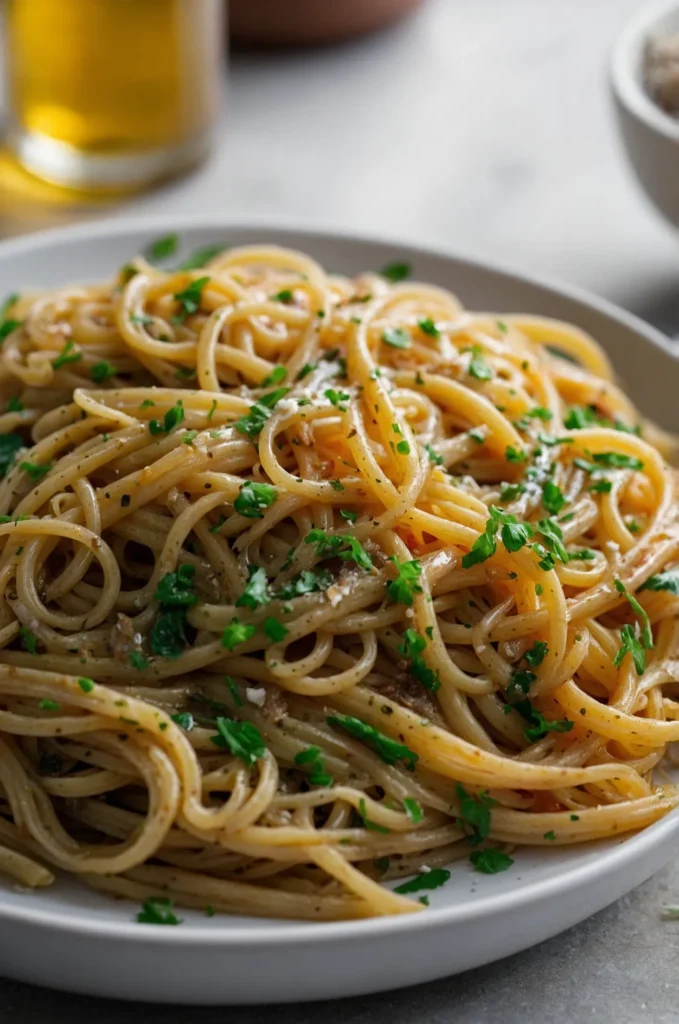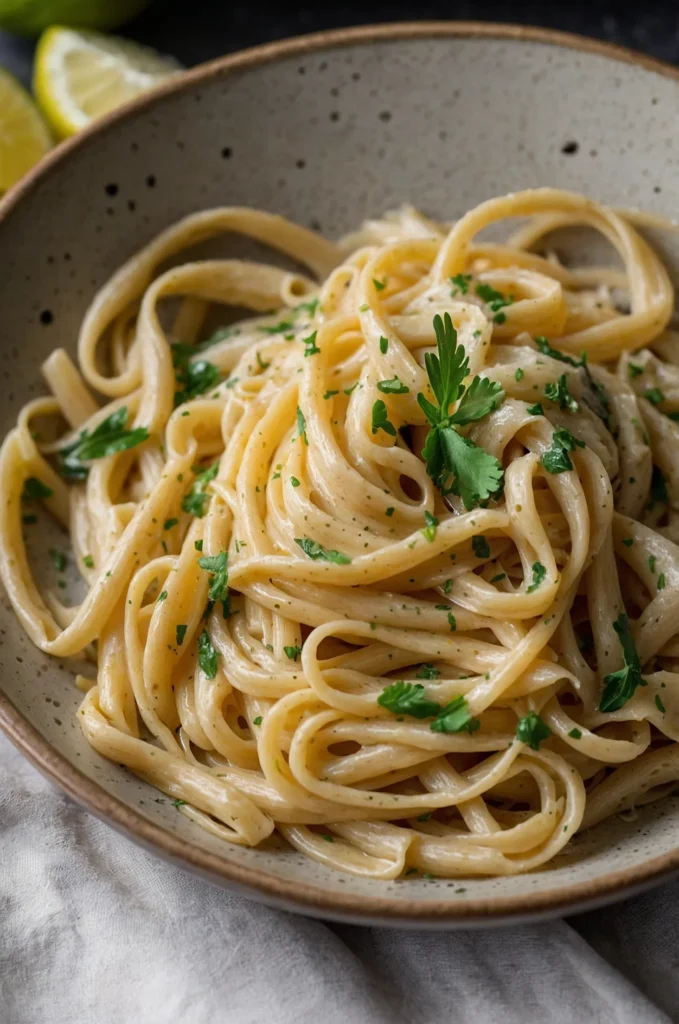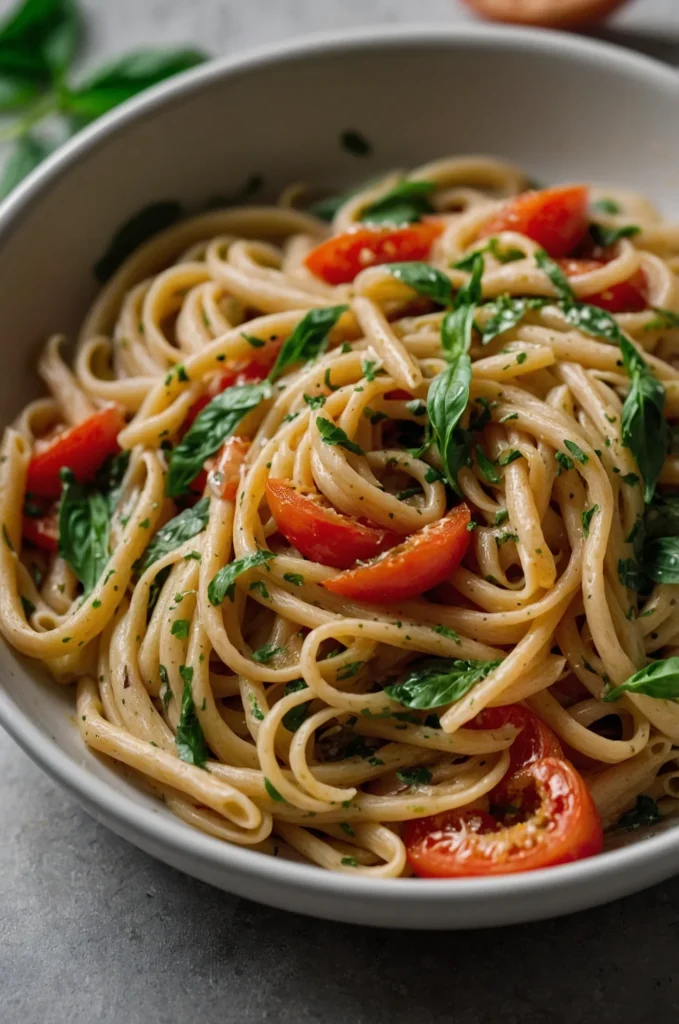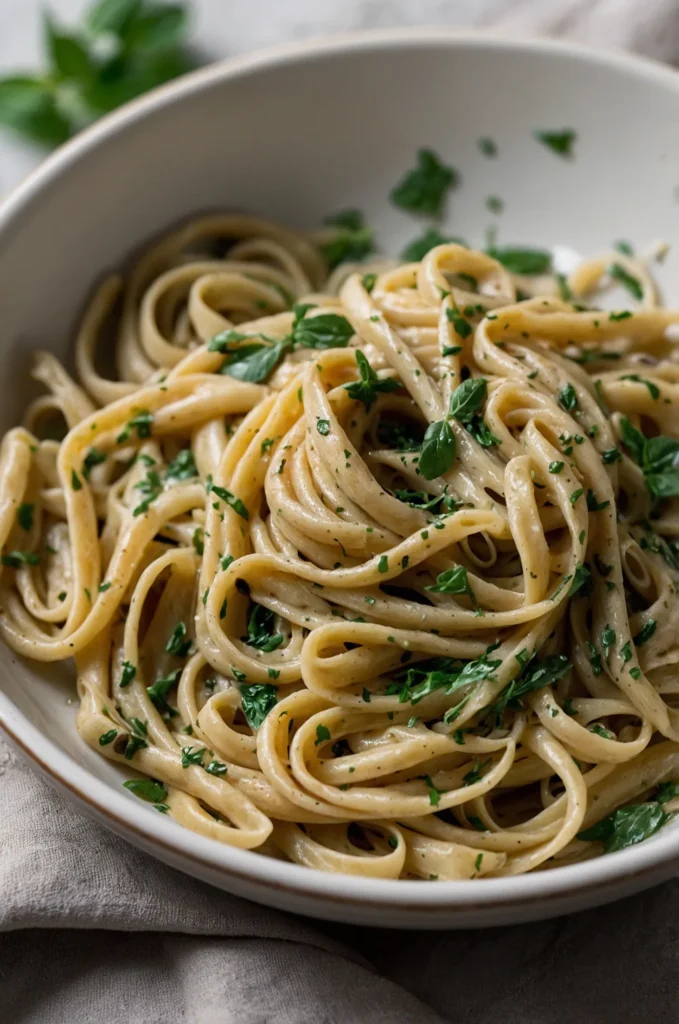Olive Oil Pasta Recipes: The Ultimate Guide to Simple Italian Elegance
Discover simple and flavorful olive oil pasta recipes that transform everyday ingredients into restaurant-worthy dishes. Perfect for quick weeknight dinners or elegant meals
Discover the delicious simplicity of olive oil pasta recipes that transform humble ingredients into extraordinary meals. From classic pasta with olive oil and garlic to authentic aglio e olio recipes and other simple olive oil pasta variations, these dishes celebrate Italian cuisine at its most elemental and beautiful.
Introduction: The Elegant Simplicity of Olive Oil Pasta
There’s something almost magical about a plate of pasta dressed simply with good olive oil, perhaps with some garlic and herbs. In a culinary world that often celebrates complexity, olive oil pasta recipes stand as a testament to the beauty of simplicity. These dishes, where olive oil forms the foundation of the sauce rather than merely a cooking medium, represent Italian cuisine in its purest form.
At its core, olive oil pasta is exactly what it sounds like—pasta dressed with a sauce where quality olive oil is the star. Unlike tomato-based or cream sauces, these olive oil pasta recipes rely on the rich, fruity character of olive oil to create a light yet satisfying coating that enhances the pasta without overwhelming it. The most famous of these is undoubtedly aglio e olio (garlic and oil), but numerous delicious variations exist, each celebrating the Mediterranean pantry in its own way.
You’ll love these olive oil pasta recipes because they’re:
- Quick to prepare: Most come together in 15-20 minutes
- Made with pantry staples: No special shopping required
- Infinitely adaptable: Easy to customize with what you have on hand
- Incredibly flavorful: Despite their simplicity
- Budget-friendly: Gourmet taste without expensive ingredients
- Perfect for weeknights or elegant entertaining: Versatile enough for any occasion
Content Overview
Table of Contents
Let’s dive into the world of olive oil pasta and discover just how satisfying simplicity can be.
Discover more Pasta & Alfredo Recipes
The Importance of Olive Oil: Choosing Liquid Gold
When olive oil forms the backbone of your sauce, its quality matters tremendously. Unlike dishes where olive oil’s flavor might be masked by other ingredients, in these recipes, you’ll taste every nuance of your chosen oil.
Choosing the Right Olive Oil
For olive oil pasta recipes, extra virgin olive oil (EVOO) is non-negotiable. Here’s why:
- Extra Virgin Olive Oil: The highest quality olive oil, made from the first cold pressing of olives without heat or chemicals. It offers complex flavors ranging from grassy and peppery to buttery and fruity.
- Virgin Olive Oil: Good quality but with slightly higher acidity and less complex flavor than EVOO.
- Regular/Pure Olive Oil: Often a blend of refined olive oil with some virgin olive oil added for flavor. Lacks the character needed for these recipes.
When shopping for olive oil for pasta, look for these characteristics:
| Characteristic | Why It Matters |
|---|---|
| Harvest date | Fresher is better; ideally within 12-18 months |
| Dark bottle | Protects oil from light damage |
| Origin | Single-source oils often have more distinctive character |
| Cold-pressed | Ensures gentle extraction that preserves flavor |
| Flavor profile | For pasta, medium-bodied oils with balanced fruitiness and pepperiness work best |
Chef’s Tip: If possible, taste olive oils before buying. Look for oils with a pleasant bitterness and a peppery finish that creates a slight burning sensation at the back of your throat—this indicates the presence of healthy polyphenols and fresh oil.
Smoke Point Considerations
While most olive oil pasta recipes don’t involve high-heat cooking, it’s worth noting that extra virgin olive oil has a smoke point of approximately 375-405°F (190-207°C). This is perfectly adequate for the gentle sautéing of garlic and other aromatics required in these recipes. If you’re concerned about overheating your precious EVOO, keep the heat medium-low when preparing the garlic and other ingredients.
Core Recipe: Perfect Aglioe Olio (Garlic & Oil Pasta)
Aglio e olio is the quintessential olive oil pasta recipe—the dish that perhaps best exemplifies Italian cooking philosophy of transforming humble ingredients into something extraordinary through proper technique. This classic from Naples consists of just five ingredients: pasta, olive oil, garlic, red pepper flakes, and parsley. Yet when prepared correctly, it delivers a depth of flavor that belies its simplicity.

Ingredients
- 1 pound (454g) spaghetti or linguine
- 1/2 cup (120ml) high-quality extra virgin olive oil
- 6-8 cloves garlic, thinly sliced (not minced)
- 1/2-1 teaspoon red pepper flakes (adjust to taste)
- 1/4 cup finely chopped fresh parsley
- Salt for pasta water (about 1 tablespoon)
- Freshly ground black pepper (optional)
- Grated Pecorino Romano or Parmesan cheese (optional, but delicious)
Step-by-Step Instructions
- Bring water to a boil: Fill a large pot with water and bring to a rolling boil. Add 1 tablespoon of salt (the water should taste salty like the sea).
- Cook the pasta: Add pasta to boiling water and cook until al dente according to package directions, typically 8-10 minutes. Reserve 1 cup of pasta cooking water before draining.
- Prepare the garlic oil: While pasta cooks, add olive oil to a large skillet over medium-low heat. Add sliced garlic and cook gently, stirring frequently, until garlic is fragrant and just beginning to turn golden at the edges, about 2-3 minutes. Do not brown the garlic or it will become bitter.
- Add heat: When garlic is golden, add red pepper flakes and cook for 30 seconds more.
- Create the emulsion: Add 1/2 cup of the reserved pasta water to the oil mixture. It will bubble vigorously—this is good! This step is crucial for creating a cohesive sauce rather than oily pasta.
- Combine and finish: Add drained pasta to the skillet and toss vigorously with tongs to coat pasta evenly with the emulsified sauce. If pasta seems dry, add more reserved pasta water, a tablespoon at a time.
- Season: Remove from heat and add chopped parsley, tossing to distribute. Taste and adjust seasoning with salt and pepper if needed.
- Serve immediately: Transfer to warm plates and serve with grated cheese if desired.
Ingredient Spotlight
Garlic: How you cut garlic dramatically affects the final dish:
- Sliced garlic (traditional for aglio e olio) provides distinct pieces and a milder, more aromatic garlic flavor
- Minced garlic creates a more intense, pervasive garlic flavor
- Smashed garlic offers a rustic texture and medium intensity
- Whole garlic cloves (removed before serving) impart a gentle background note
Pasta: While long pasta shapes are traditional for aglio e olio, choose pasta with these characteristics:
- Long shapes like spaghetti, linguine, or bucatini hold the light sauce well
- Bronze-cut pasta with a rougher texture helps the sauce cling better
- Dried pasta works better than fresh for this dish, as it releases more starch into the cooking water
Red Pepper Flakes: These provide the subtle heat characteristic of many southern Italian dishes:
- Traditional Italian peperoncino offers a complex flavor beyond just heat
- For authentic flavor, look for flakes that include seeds
- Start with less and adjust to your preference—the dish should have a pleasant warmth, not overwhelming spice
Visual Guide to Perfect Aglio e Olio
- Properly cooked garlic should be a pale golden color, never dark brown
- Perfectly emulsified sauce should cling to the pasta, not pool at the bottom of the plate
- Finished pasta should glisten with oil but not appear greasy
Simple Olive Oil Pasta Variations
Once you’ve mastered the basic aglio e olio, a world of simple olive oil pasta variations opens up to you. Here are five delicious ways to build on the foundation of pasta with olive oil and garlic.
Lemon Olive Oil Pasta
This bright, acidic variation adds citrus to cut through the richness of the olive oil, creating a perfectly balanced dish that pairs beautifully with seafood.

Ingredients:
- 1 pound (454g) linguine or spaghetti
- 1/2 cup (120ml) high-quality extra virgin olive oil
- 4 cloves garlic, thinly sliced
- Zest of 2 lemons
- Juice of 1-2 lemons (about 1/4 cup)
- 1/4 cup chopped fresh parsley
- 1/4 cup grated Parmesan cheese, plus more for serving
- Salt and freshly ground black pepper to taste
- Red pepper flakes (optional)
Instructions:
- Cook pasta in well-salted water until al dente. Reserve 1 cup of pasta water before draining.
- While pasta cooks, warm olive oil over medium-low heat. Add garlic and cook until fragrant and just beginning to color, 1-2 minutes.
- Add lemon zest and red pepper flakes (if using) to the oil and cook for 30 seconds.
- Add 1/2 cup pasta water to create an emulsion.
- Add drained pasta, lemon juice, parsley, and cheese to the skillet. Toss vigorously until pasta is well coated.
- Season with salt and pepper to taste. Add more pasta water if needed to create a silky sauce.
- Serve with additional Parmesan and a drizzle of fresh olive oil.
Balancing Acidity: The key to perfect lemon pasta is finding the right balance between the acid of the lemon and the richness of the olive oil. Start with the juice of one lemon and add more to taste. If your sauce becomes too acidic, add a bit more olive oil or pasta water to balance it out.
Olive Oil Pasta with Tomatoes & Basil
This summer-inspired variation adds juicy tomatoes and fragrant basil to the base of olive oil and garlic, creating a light yet satisfying dish that celebrates the season’s bounty.

Ingredients:
- 1 pound (454g) pasta (spaghetti or shorter shapes like gemelli work well)
- 1/2 cup (120ml) extra virgin olive oil
- 4 cloves garlic, thinly sliced
- 2 pints cherry tomatoes, halved (or 4 medium fresh tomatoes, diced)
- 1/4 teaspoon red pepper flakes
- 1 cup fresh basil leaves, torn or roughly chopped
- Salt and freshly ground black pepper
- Grated Parmesan or crumbled feta cheese (optional)
Discover more Pasta & Alfredo Recipes
Instructions:
- Cook pasta in salted water until al dente. Reserve 1 cup of pasta water before draining.
- While pasta cooks, heat olive oil in a large skillet over medium heat. Add garlic and cook until fragrant, about 1 minute.
- Add halved cherry tomatoes and red pepper flakes. Cook, stirring occasionally, until tomatoes begin to soften and release their juices, 5-7 minutes.
- Add 1/2 cup pasta water to the skillet. Using a wooden spoon, gently press some of the tomatoes to release more juice.
- Add drained pasta to the skillet along with half of the basil. Toss to coat, adding more pasta water if needed to create a silky sauce.
- Remove from heat, add remaining basil, and season with salt and pepper.
- Serve with cheese if desired.
Fresh vs. Canned Tomatoes: While fresh tomatoes are ideal for this summer dish, you can make a delicious version year-round by substituting one 14oz can of diced tomatoes (drained) or cherry tomatoes. For canned tomatoes, extend the cooking time to 10-15 minutes to develop flavor.
Mediterranean Olive Oil Pasta
This variation takes inspiration from the broader Mediterranean basin, incorporating briny olives, tangy feta, and sweet sun-dried tomatoes for a more substantial dish that still celebrates olive oil as its foundation.

Ingredients:
- 1 pound (454g) short pasta like penne or farfalle
- 1/2 cup (120ml) extra virgin olive oil
- 4 cloves garlic, minced
- 1/4 cup sun-dried tomatoes, chopped
- 1/3 cup kalamata olives, pitted and halved
- 2 tablespoons capers, rinsed
- 1/2 teaspoon dried oregano
- 1/4 teaspoon red pepper flakes
- 2 tablespoons fresh lemon juice
- 1/4 cup chopped fresh herbs (parsley, basil, or oregano)
- 1/2 cup crumbled feta cheese
- Salt and freshly ground black pepper
Instructions:
- Cook pasta in salted water until al dente. Reserve 1 cup of pasta water before draining.
- In a large skillet, warm olive oil over medium heat. Add garlic and cook until fragrant, about 1 minute.
- Add sun-dried tomatoes, olives, capers, dried oregano, and red pepper flakes. Cook for 2-3 minutes to meld flavors.
- Add 1/2 cup pasta water to create an emulsion.
- Add drained pasta to the skillet along with lemon juice. Toss well to coat.
- Remove from heat and stir in fresh herbs and most of the feta cheese, reserving some for garnish.
- Season with salt and pepper to taste.
- Serve topped with the remaining feta cheese.
Ingredient Alternatives: This recipe is incredibly flexible. Substitute green olives for kalamata, use roasted red peppers instead of sun-dried tomatoes, or try goat cheese instead of feta.
Spicy Olive Oil Pasta (Arrabiata-Style)
For those who enjoy heat, this spicy variation takes inspiration from pasta all’arrabiata (“angry” pasta), bringing a fiery kick to the olive oil and garlic foundation.
Ingredients:
- 1 pound (454g) pasta (traditionally penne, but spaghetti works too)
- 1/2 cup (120ml) extra virgin olive oil
- 4-6 cloves garlic, thinly sliced
- 1-2 tablespoons red pepper flakes (adjust according to heat preference)
- 1 cup cherry tomatoes, halved (optional)
- 2 tablespoons tomato paste (optional, for deeper flavor)
- 2 tablespoons chopped fresh parsley
- Salt to taste
- Grated Pecorino Romano cheese (optional)
Instructions:
- Cook pasta in salted water until al dente. Reserve 1 cup of pasta water before draining.
- In a large skillet, heat olive oil over medium-low heat. Add garlic and cook until just fragrant, about 1 minute.
- Add red pepper flakes and cook for 30 seconds to infuse the oil with heat.
- If using, add tomatoes and cook until they begin to break down, 5-7 minutes.
- If using tomato paste, add it now and cook for 1-2 minutes to caramelize slightly.
- Add 1/2 cup pasta water and stir to create a cohesive sauce.
- Add drained pasta to the skillet and toss vigorously until well coated. Add more pasta water if needed.
- Stir in parsley and season with salt to taste.
- Serve with grated cheese if desired.
Building Heat: For best results, build layers of heat by adding red pepper flakes at different stages. Start with half in the oil, then adjust final spice level by adding more at the end if desired.
Olive Oil Pasta with Vegetables
This versatile variation adds seasonal vegetables to the olive oil pasta base, creating a more nutritious complete meal while still highlighting the quality of the olive oil.
Ingredients:
- 1 pound (454g) pasta (short shapes like orecchiette or farfalle work well)
- 1/2 cup (120ml) extra virgin olive oil, plus more for serving
- 4 cloves garlic, thinly sliced
- 4 cups mixed vegetables, cut into bite-sized pieces (suggestions: zucchini, bell peppers, asparagus, mushrooms, cherry tomatoes, spinach)
- 1/4 teaspoon red pepper flakes (optional)
- 2 tablespoons fresh herbs (basil, parsley, or thyme)
- 2 tablespoons fresh lemon juice
- Salt and freshly ground black pepper
- Grated Parmesan cheese (optional)
Instructions:
- Cook pasta in salted water until al dente. Reserve 1 cup of pasta water before draining.
- While pasta cooks, heat olive oil in a large skillet over medium heat. Add garlic and cook until fragrant, about 1 minute.
- Add firmer vegetables first (like bell peppers, zucchini), cooking for 2-3 minutes until slightly softened.
- Add quicker-cooking vegetables (like mushrooms, cherry tomatoes) and red pepper flakes, cooking for 2-3 minutes more.
- If using leafy greens like spinach, add them last, just until wilted.
- Add 1/2 cup pasta water to create an emulsion.
- Add drained pasta to the skillet along with lemon juice and herbs. Toss to coat evenly.
- Season with salt and pepper to taste.
- Serve drizzled with additional olive oil and topped with cheese if desired.
Seasonal Variations:
- Spring: Asparagus, peas, artichokes
- Summer: Zucchini, eggplant, cherry tomatoes, bell peppers
- Fall: Mushrooms, kale, butternut squash
- Winter: Broccoli, cauliflower, Brussels sprouts
Technique & Tips for Success
The magic of olive oil pasta recipes isn’t just in the ingredients but in the technique. Master these fundamentals to elevate your dishes from good to extraordinary.
Discover more Pasta & Alfredo Recipes
The Magic of Pasta Water: Liquid Gold
Pasta cooking water is perhaps the most overlooked ingredient in pasta preparation, yet it’s essential for creating proper olive oil pasta dishes.
Why pasta water is crucial:
- Contains starch released from the pasta during cooking
- Acts as an emulsifier, helping oil and water mix into a cohesive sauce
- Adds seasoning (from the salt)
- Provides the perfect consistency without diluting flavor
How to use pasta water effectively:
- Salt your water properly – Use 1 tablespoon of salt per gallon of water
- Don’t overcook pasta – More cooking means more starch in the water, but overcooked pasta ruins texture
- Reserve at least 1 cup before draining – You won’t need it all, but better to have extra
- Add it hot to your olive oil mixture for the best emulsification
Pro tip: For even starchier water (great for difficult emulsifications), cook pasta in less water than usual—about 2 quarts instead of 4 for a pound of pasta.
Achieving Perfect Emulsification
Emulsification—the process of combining oil and water into a cohesive mixture—is what transforms plain oily pasta into a properly sauced dish with a silky coating.
Steps to perfect emulsification:
- Add hot pasta water to the olive oil mixture while it’s still hot
- Toss vigorously (tongs work best for long pasta)
- Keep everything moving in the pan
- If needed, add more pasta water a little at a time
How to know you’ve achieved proper emulsification:
- Sauce looks glossy, not greasy
- Oil doesn’t separate and pool at the bottom of the pan
- Pasta is evenly coated with a light, silky sauce
Pasta Cooking Perfection
Al dente pasta—cooked “to the tooth” with a slight firmness in the center—is essential for olive oil pasta recipes.
Why al dente matters:
- Provides better texture and mouthfeel
- Holds up better when tossed with sauce
- Has a lower glycemic index
- Continues cooking slightly when tossed with hot oil
How to achieve perfect al dente pasta:
- Use plenty of water
- Bring to a full rolling boil before adding pasta
- Stir immediately after adding pasta to prevent sticking
- Taste frequently toward the end of cooking time
- Aim for 1-2 minutes less than the package directions
- Remember: pasta will continue cooking slightly when tossed with hot oil
Discover more Pasta & Alfredo Recipes
Common Mistakes to Avoid
Even experienced cooks can fall prey to these common pitfalls when making olive oil pasta dishes:
| Mistake | Problem | Solution |
|---|---|---|
| Burning the garlic | Creates bitter, acrid flavors | Use medium-low heat and watch carefully; remove from heat as soon as garlic is fragrant |
| Using too much olive oil | Makes pasta greasy instead of coated | Start with less (about 1/4 cup per pound) and add more if needed |
| Using too little olive oil | Results in dry, sticky pasta | Don’t be too stingy—this is an olive oil-based dish! |
| Skipping pasta water | Prevents proper emulsification | Always reserve at least 1 cup before draining |
| Undersalting pasta water | Drain quickly or use tongs to transfer pasta directly to the sauce | Water should taste like the sea |
| Draining pasta too thoroughly | Makes it difficult to create a cohesive sauce | Drain quickly or use tongs to transfer pasta directly to sauce |
Serving Suggestions & Pairings
Olive oil pasta dishes shine when paired thoughtfully with complementary foods and beverages.
What to Serve Alongside
Proteins that pair perfectly:
- Grilled or roasted chicken
- Sautéed shrimp or scallops
- Italian sausage
- Baked white fish
- Grilled steak (especially with garlicky variations)
Vegetables and salads:
- Arugula salad with lemon vinaigrette
- Roasted vegetables (especially Mediterranean varieties)
- Caprese salad
- Simple green salad with vinaigrette
- Sautéed leafy greens
Breads:
- Crusty Italian bread
- Garlic bread
- Focaccia
- Bruschetta
Wine Pairings
The best wine pairings for olive oil pasta recipes depend on the specific variation and ingredients:
For classic aglio e olio:
- Crisp white wines: Pinot Grigio, Vermentino, Sauvignon Blanc
- Light-bodied reds: Chianti, Valpolicella, Pinot Noir
For lemon variations:
- High-acid whites: Greco di Tufo, Assyrtiko, Albariño
For spicy variations:
- Off-dry whites: Riesling, Gewürztraminer
- Fruit-forward reds: Primitivo, Zinfandel
For vegetable-forward or Mediterranean variations:
- Versatile rosés
- Medium-bodied whites: Verdicchio, Gavi, Soave
Frequently Asked Questions
Can I use regular olive oil instead of extra virgin?
While technically possible, regular olive oil lacks the flavor complexity that makes these dishes special. Since olive oil is the star ingredient, use the best extra virgin olive oil you can afford. If you must substitute, consider adding additional aromatics like herbs or lemon zest to compensate for the reduced flavor.
Can I make olive oil pasta dishes gluten-free?
Absolutely! Use your favorite gluten-free pasta, but be aware of these considerations:
- Gluten-free pasta typically releases less starch, so your pasta water won’t be as effective for emulsification
- Cook according to package directions, as cooking times vary widely
- Consider adding a small amount (1/4 teaspoon) of xanthan gum to your sauce to help with emulsification if needed
- Rice-based pasta works better than corn-based pasta for these dishes
How do I store and reheat leftovers?
Olive oil pasta dishes are best enjoyed immediately after preparation, but can be stored:
- Refrigerate in an airtight container for up to 2 days
- To reheat: Add a splash of water or broth, then warm gently in a skillet over medium-low heat
- Expect the texture to be slightly less ideal than when freshly made
- Consider adding a drizzle of fresh olive oil after reheating to brighten flavors
Can I add cheese to olive oil pasta?
While purists might argue that the simplest aglio e olio should be cheese-free, most variations benefit from:
- Pecorino Romano: Sharper, saltier, more traditional in Southern Italian cooking
- Parmesan: Nuttier, more widely available
- Ricotta Salata: Adds a mild, salty touch
- Feta: Excellent in Mediterranean variations
Traditional Italian wisdom suggests avoiding cheese with seafood variations.
What’s the difference between aglio e olio and spaghetti with olive oil and garlic?
Technically, they’re the same dish! “Aglio e olio” simply means “garlic and oil” in Italian. However, authentic Italian aglio e olio specifically refers to the Neapolitan preparation where garlic is gently sautéed in olive oil (never browned), often with a touch of red pepper flakes, and tossed with al dente pasta and some pasta cooking water. Other “spaghetti with olive oil and garlic” recipes might take liberties with these basic techniques.
Recipe Card: Classic Aglio e Olio
Spaghetti Aglio e Olio (Classic Garlic and Oil Pasta)
Prep Time: 5 minutes | Cook Time: 15 minutes | Total Time: 20 minutes | Servings: 4
Ingredients:
- 1 pound (454g) spaghetti or linguine
- 1/2 cup (120ml) high-quality extra virgin olive oil
- 6-8 cloves garlic, thinly sliced
- 1/2-1 teaspoon red pepper flakes (adjust to taste)
- 1/4 cup finely chopped fresh parsley
- Salt for pasta water (about 1 tablespoon)
- Freshly ground black pepper (optional)
- Grated Pecorino Romano or Parmesan cheese (optional)
Instructions:
- Bring a large pot of water to a rolling boil. Add 1 tablespoon salt.
- Add pasta and cook until al dente according to package directions.
- Meanwhile, in a large skillet, heat olive oil over medium-low heat.
- Add sliced garlic and cook, stirring frequently, until fragrant and just turning golden at edges, 2-3 minutes. Do not brown.
- Add red pepper flakes and cook for 30 seconds more.
- Reserve 1 cup of pasta cooking water before draining pasta.
- Add 1/2 cup of the reserved pasta water to the oil mixture. It will bubble vigorously.
- Add drained pasta to the skillet and toss vigorously with tongs to coat evenly with the sauce.
- If pasta seems dry, add more reserved pasta water, a tablespoon at a time.
- Remove from heat and add chopped parsley, tossing to distribute.
- Taste and adjust seasoning with salt and pepper if needed.
- Serve immediately, topped with grated cheese if desired.
Nutrition Information (per serving):
- Calories: 590
- Fat: 24g
- Carbohydrates: 77g
- Protein: 14g
- Sodium: 590mg
- Fiber: 3g
Note: Nutritional information is an estimate only.
Print Recipe | Pin for Later | Share on Facebook
Conclusion: The Timeless Appeal of Olive Oil Pasta
In a world of complicated recipes and exotic ingredients, there’s something profoundly satisfying about returning to the basics. Olive oil pasta recipes remind us that extraordinary dishes don’t require lengthy ingredient lists or complicated techniques—just quality ingredients and proper preparation.
These dishes have endured for generations in Italian cooking precisely because they celebrate the ingredients in their purest form. A good olive oil pasta allows you to taste the wheat in the pasta, the fruitiness of the oil, the pungency of the garlic, and the freshness of the herbs. It’s cooking distilled to its essence.
Whether you choose the classic aglio e olio or one of its many variations, these recipes provide a template for countless quick, satisfying meals from pantry staples. They demonstrate that sometimes, less is more.
We encourage you to start with the classic recipe and then explore the variations, adapting them to your taste and what you have on hand. Once you master the basic techniques—particularly the crucial step of emulsification using pasta water—you’ll find yourself improvising your own variations with confidence.
What’s your favorite way to prepare olive oil pasta? Have you tried any of these recipes or created your variation? We’d love to hear about your experiences in the comments below!
This comprehensive guide to olive oil pasta recipes was created to help you discover the beautiful simplicity of pasta with olive oil and garlic, authentic aglio e olio recipes, and other simple olive oil pasta variations. With these techniques in your culinary arsenal, you’ll never be more than 20 minutes away from a delicious meal.

